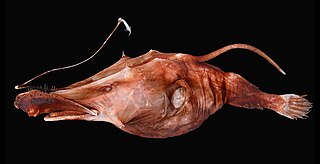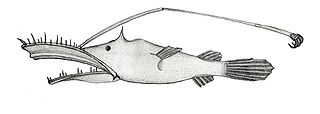
In physics, refraction is the redirection of a wave as it passes from one medium to another. The redirection can be caused by the wave's change in speed or by a change in the medium. Refraction of light is the most commonly observed phenomenon, but other waves such as sound waves and water waves also experience refraction. How much a wave is refracted is determined by the change in wave speed and the initial direction of wave propagation relative to the direction of change in speed.

Glaucoma is a group of eye diseases that result in damage to the optic nerve and cause vision loss. The most common type is open-angle glaucoma, in which the drainage angle for fluid within the eye remains open, with less common types including closed-angle glaucoma and normal-tension glaucoma. Open-angle glaucoma develops slowly over time without pain. Peripheral vision may begin to decrease, followed by central vision, resulting in blindness if not treated. Closed-angle glaucoma can present gradually or suddenly. The sudden presentation may involve severe eye pain, blurred vision, mid-dilated pupil, redness of the eye, and nausea. Vision loss from glaucoma, once it has occurred, is permanent. Eyes affected by glaucoma are referred to as being glaucomatous.

The scapula, also known as the shoulder blade, is the bone that connects the humerus with the clavicle. Like their connected bones, the scapulae are paired, with each scapula on either side of the body being roughly a mirror image of the other. The name derives from the Classical Latin word for trowel or small shovel, which it was thought to resemble.

Crappies are two species of North American freshwater fish of the genus Pomoxis in the family Centrarchidae (sunfishes). Both species of crappies are popular game fish among recreational anglers.
Wolf Trap or wolf trap may refer to:

In vertebrate anatomy, hip refers to either an anatomical region or a joint.
Browns Mill is an unincorporated community in Fairfax County, Virginia, United States. Browns Mill is located at the intersection of Beulah and Browns Mill Roads midway between the Dulles Toll Road and the Leesburg Pike. Nearby is Wolftrap Stream Valley Park and Wolftrap Creek, which Browns Mill once operated upon.

Bicycle and motorcycle geometry is the collection of key measurements that define a particular bike configuration. Primary among these are wheelbase, steering axis angle, fork offset, and trail. These parameters have a major influence on how a bike handles.

Lasiognathus saccostoma is a species of wolftrap angler known from the eastern central Pacific Ocean and tropical waters of the Atlantic Ocean. It is found at depths to 4,000 metres (13,000 ft). The females of this species grow to a length of 7.7 centimetres (3.0 in) SL. This species has a slender, compressed prolongation at the tip of its elongated, cylindrical distal escal appendage, with numerous lateral serrations and distal filaments. Unlike in L. amphirhamphus, there are three escal hooks and they are darkly pigmented. The posterior escal appendage is broad and laterally compressed, and relatively larger than in L. amphirhamphus. No males or larval specimens have ever been found.
Cecil C. Steiner was a dentist and one of Edward H. Angle's first students in 1921. He developed a form of cephalometric analysis, presented in 1953, referred to as the Steiner method of analysis.

The Wonderfish (Thaumatichthys) is a genus of deep-sea anglerfish in the family Thaumatichthyidae, with three known species. Its scientific name means "wonder-fish" in Greek; oceanographer Anton Bruun described these fishes as "altogether one of the oddest creatures in the teeming variety of the fish world." In contrast to other anglerfishes, the bioluminescent lure of Thaumatichthys is located inside its cavernous mouth. They are worldwide in distribution and are ambush predators living near the ocean floor.

Thaumatichthys binghami is a species of wolftrap angler known from the western central Atlantic Ocean, where it occurs at a depth of 2,532 metres (8,307 ft). This species is similar to T. axeli, except that its esca bears 2–3 pairs of lateral lobes that are elongated into tapering filaments in the largest individuals, and the uppermost medial appendage on the esca is finger-like and tapering.

The Compleat Anglerfish (Lasiognathus) is a genus of deep-sea anglerfish in the family Thaumatichthyidae, with six species known from the Atlantic and Pacific Oceans. Its lure apparatus appears to consist of a fishing rod, a fishing line, bait, and hooks. It is also distinctive for an enormous upper jaw with premaxillaries that can be folded down to enclose the much shorter lower jaw.

Lasiognathus amphirhamphus is a species of wolftrap angler found in the Madeira Abyssal Plain in the east-central Atlantic Ocean where it occurs at a depth of from 1,200 to 1,305 metres. The females of this species grow to a length of 15.7 centimetres (6.2 in) SL. This species is characterized by having only two bony hooks on its esca, which are lightly pigmented. The distal escal appendage is elongated and cylindrical with a long, compressed prolongation at the tip as in L. saccostoma. The prolongation has six tiny filaments at the tip and no lateral serrations. The posterior escal appendage is broad and laterally compressed. Its species name is from the Greek for "double hook", referring to its escal hooks.

Lasiognathus beebei is a species of wolftrap angler known from around the Hawaiian Islands in the Pacific Ocean and from around Madeira and Bermuda in the Atlantic. It is found at depths of around 1,100 metres (3,600 ft). The females of this species grow to a length of 11.5 centimetres (4.5 in) TL. This species is distinguishable by its hooks being placed on a short, transverse, fan-shaped distal escal appendage as opposed to the elongated, cylindrical appendage of all other species. Its species name honors naturalist William Beebe.
Lasiognathus intermedius is a species of wolftrap angler known from the western Atlantic Ocean and the southeastern Pacific Ocean where it occurs at depths of around 1,265 metres (4,150 ft). The females of this species grow to a length of 12.9 centimetres (5.1 in) SL. This species has an elongated, cylindrical distal appendage with a short, cylindrical prolongation at the tip without any lateral serrations or filaments. The posterior escal appendage is cylindrical in shape. Its species name refers to its esca being intermediate in shape between those of L. beebei and those of L. saccostoma and L. waltoni.
Lasiognathus waltoni is a species of wolftrap angler known from the eastern central Pacific Ocean. This species is found at depths to around 1,350 metres (4,430 ft). The females of this species grow to a length of 9.4 centimetres (3.7 in) SL. This species is characterized by a membranous anterior crest on its escal bulb, and an elongated, cylindrical distal escal appendage without a prolongation at the tip. Its species name honors Sir Isaac Walton, author of The Compleat Angler.

The anglerfish are fish of the teleost order Lophiiformes. They are bony fish named for their characteristic mode of predation, in which a modified luminescent fin ray acts as a lure for other fish. The luminescence comes from symbiotic bacteria, which are thought to be acquired from seawater, that dwell in and around the sea.

Wolftrap Mountain is a mountain in counties Laois and Offaly, Ireland. The mountain is 487 metres (1,598 ft) high, making it the third-highest summit in Offaly, the fourth-highest mountain in the Slieve Bloom Mountains and the 602th-highest summit in Ireland. It is the most northerly summit of the Slieve Bloom range.
Lasiognathus dinema is a species of wolftrap angler found in the deep waters of the northern Gulf of Mexico. It is found at depths of around 3,280 to 4,900 feet.













